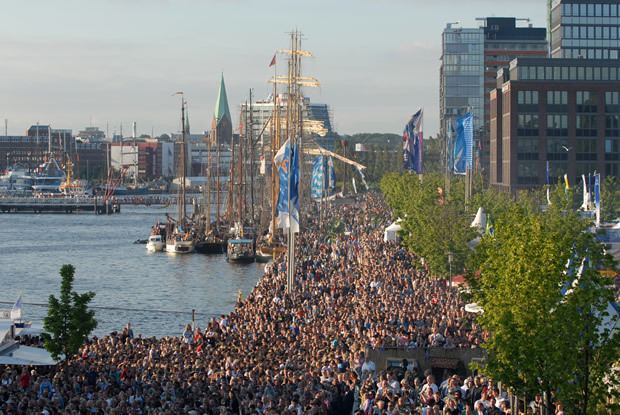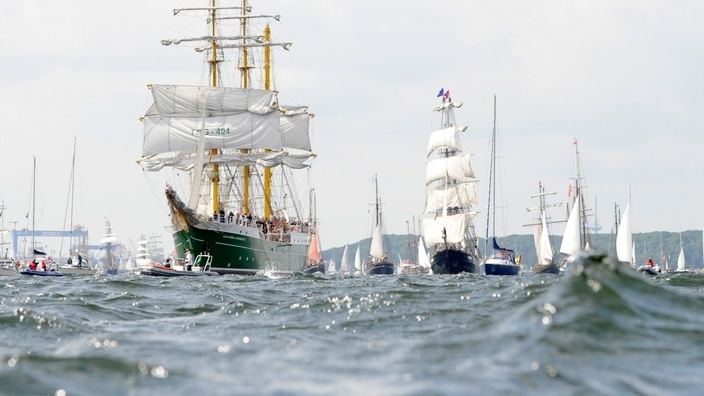Founded 1882 | Official website kieler-woche.de | |
 | ||
Organizer Classes 2.4mR, 29er, 420, 470, 49er, 49er FX, 505, Albin Express, Bavaria B/One, Contender, Europe, Finn, Flying Dutchman, Formula 18, Hobie 16, J/24, J/70, J/80, Laser 4.7, Laser Radial, Laser, Melges 24, Musto Performance Skiff, Nacra 17, Nordic Folkboat, OK, ORC, Platu 25, SB20, Sonar, X-99 Similar | ||
Kiel week euromaxx
The Kiel Week (German: Kieler Woche) or Kiel Regatta is an annual sailing event in Kiel, the capital of Schleswig-Holstein, Germany. It is the largest sailing event in the world, and also one of the largest Volksfeste in Germany, attracting millions of people every year from all over Germany and neighbouring countries.
Contents

Welcome to kiel week
Events
Kiel Week is held annually in the last week in June, and opens officially on the preceding Saturday with the official Glasen, followed by the Holstenbummel. The "Soundcheck" is on the Friday before the official opening; it is a music festival across all the stages within the city. Kiel Week ends with a large fireworks display at 11 p.m. on Sunday, fired from pontoons or the quays at the Howaldtswerke, visible all across the Bay of Kiel.

Most ship races begin at the Olympic Harbor of Schilksee, also the center of most sporting activities during Kiel Week. As Schilksee is located outside of the inner city and most sailing competitions take place yet further out, only some races - mainly of smaller boat types - can be viewed from shore, namely from along the Kiellinie at the west coast of the Bay of Kiel.

Kiel Week usually gathers around 5,000 sailors, 2,000 ships, and about three million visitors each year. The event is organized in joint effort by the Yacht Club of Kiel, the Norddeutscher Regattaverein, the Hamburger Sailing Club, and the Verein Seglerhaus am Wannsee.

While Kiel Week started out as a ship racing championship, it has long since become a large festival with many popular bands playing on public stages. They often play for free, although the corporate sponsors (many from the Schleswig-Holstein media and telecommunications industry) usually display their involvement prominently. Most of the stages can be found at the Kiellinie (the western side of the Kieler Förde from the Düsternbrook yacht harbor past the Schleswig-Holstein parliament building to the big inner city ferry harbor), and as of late, across the Hoernbridge to the Germania harbor and the Hörn. Another area of rich cultural activity is the city center (Rathausplatz, Holstenbrücke) and the area connecting the city center with the ferry harbor (Alter Markt, Dänische Straße, Schloßpark). Between the public stages and especially on the International Market on the Rathausplatz, food specialties from different countries can be eaten. Small street performances and street comedy are performed in many places. A special children's program is available at the Spiellinie.
Kiel Week is also one of the largest tall ship conventions in Germany, attracting many German and international traditional ships, mainly sailing ships. Many of them spend the week doing day tours out of Kiel, thus berthing much more in view of the festival visitors than the racing boats at Kiel-Schilksee. More than 100 traditional ships and hundreds of yachts usually participate in the Tall Ships Parade (Windjammerparade) on the day before the closing day of the Kiel Week, i.e. usually on the second Saturday of Kiel Week. The Parade was first held in 1972, under the name of Operation Sail, and was organized in celebration of the Olympic Summer Games in Germany that year, whose sailing competitions took place in Kiel. It was the first large gathering of tall ships since the time of the windjammers, and its success led to the annual Parade and to the foundation of the first sail training organization in Germany (Clipper DJS). Today, the Parade is often headed by the Gorch Fock, a sister ship to the German-built USCGC Eagle (WIX-327).
Kiel Week Poster
Since 1948, advertises an annual Kiel Week poster for the festival week. Their design is another example of the cultural positioning and visual-design tradition of the Kieler Woche. In this context represents a jury put together a selection of graphic and then invites them to a competition to the corporate design of the festival week. An invitation is already an honor, because the design contest enjoys a high reputation and many designs have been awarded national and international prizes.
Among other things, the following graphic artists designed for the Kiel Week: Ernst Irmler (1953), Anton Stankowski (1962), Hans Hillmann (1964), Michael Engelmann (1965), Bruno K. Wiese (1971 & 1982), Rolf Müller (, 1972), Otto Treumann (1975), Ruedi Baur (1986), Rosemarie Tissi (1990), Hans Günther Schmitz (1992), Christof Gassner (1993), Siegfried Odermatt (1994), Barbara & Gerd Baumann (1995), Wim Crouwel (1998 ), Fons M. Hickmann (2002), Klaus Hesse (2006), Markus Dressen (2007), Peter Zizka (2008), Henning Wagenbreth (2009), Andrew and Jeffrey Goldstein (2010), Melchior Imboden (2011) and Stefan Guzy and Björn re (2015).
The series of Kieler Woche placards considered as a reflection of the recent graphic story. The motifs are applied to many objects and almost all of these - mostly developed by the competition winner himself - applications reach after a short time collector status.
